Front end panel FORD FIESTA 2007 Workshop Manual
[x] Cancel search | Manufacturer: FORD, Model Year: 2007, Model line: FIESTA, Model: FORD FIESTA 2007Pages: 1226, PDF Size: 61.26 MB
Page 4 of 1226
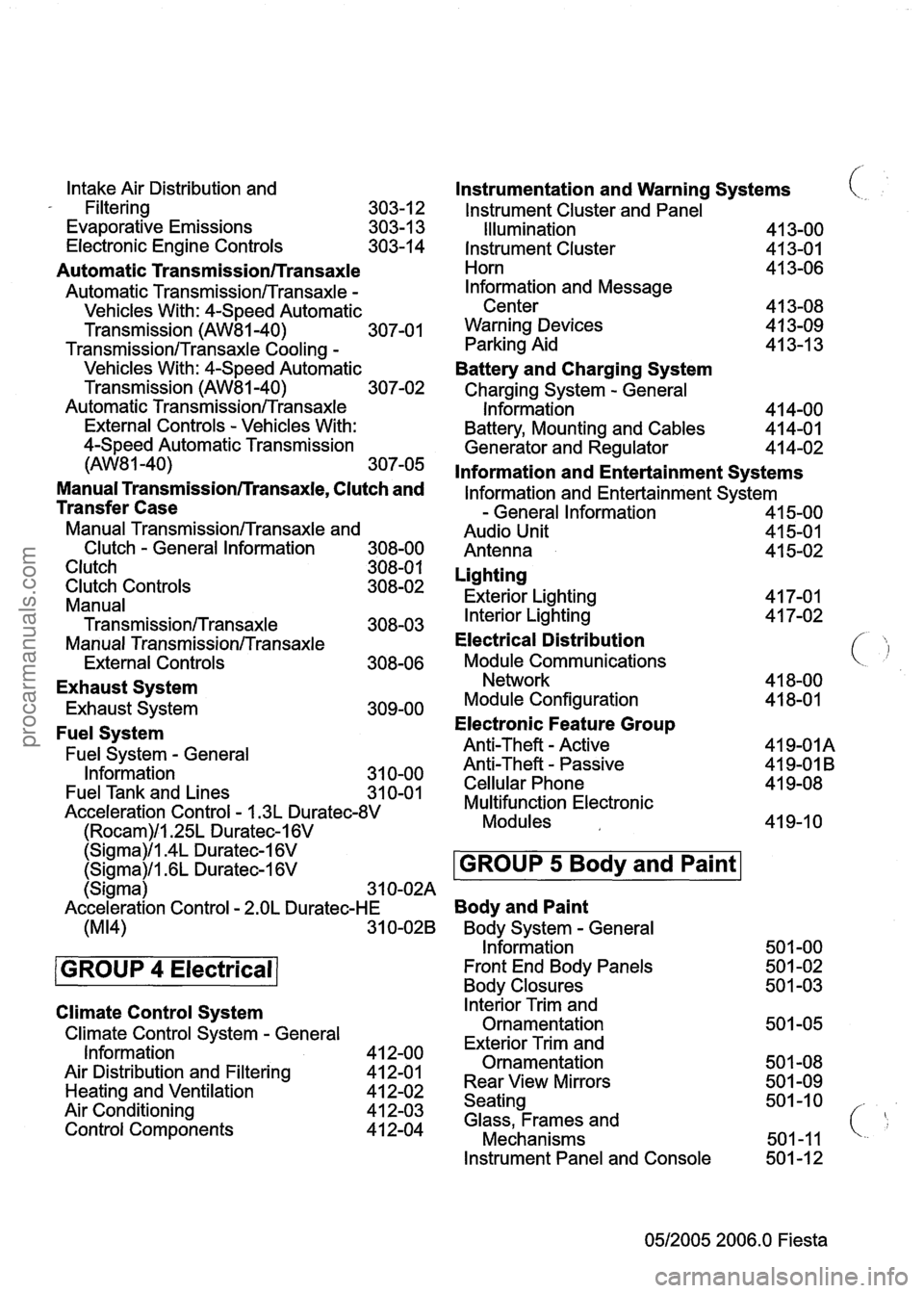
Intake Air Distribution and
- Filtering
303-1 2
Evaporative Emissions 303-1 3
Electronic Engine Controls 303-14
Automatic Transmission/Transaxle
Automatic TransmissionlTransaxle -
Vehicles With: 4-Speed Automatic
Transmission
(AW81-40) 307-01
TransmissionlTransaxle Cooling -
Vehicles With: 4-Speed Automatic
Transmission
(AW81-40) 307-02
Automatic
TransmissionlTransaxle
External Controls - Vehicles With:
4-Speed Automatic Transmission
(AW8 1 -40) 307-05
Manual Transmissionrrransaxle, Clutch and
Transfer Case
Manual TransmissionlTransaxle and
Clutch
- General Information 308-00
Clutch 308-0 1
Clutch Controls 308-02
Manual
Transmission/Transaxle 308-03
Manual TransmissionlTransaxle
External Controls 308-06
Exhaust System
Exhaust System 309-00
Fuel System
Fuel System - General
Information 31 0-00
Fuel Tank and Lines
31 0-01
Acceleration Control - I .3L Duratec-8V
(Rocam)ll.25L Duratec-I 6V
Instrumentation and Warning Systems
lnstrument Cluster and Panel
(
Illumination 41 3-00
Instrument Cluster
413-01
Horn 41 3-06
lnformation and Message
Center 41 3-08
Warning Devices
4 1 3-09
Parking Aid 41 3-1 3
Battery and Charging System
Charging System - General
Information 4 14-00
Battery, Mounting and Cables 414-01
Generator and Regulator 41 4-02
lnformation and Entertainment Systems
lnformation and Entertainment System
- General Information 41 5-00
Audio Unit 41 5-01
Antenna 41 5-02
Lighting
Exterior Lighting 41 7-01
Interior Lighting 4 1 7-02
Electrical Distribution
Module Communications ( 'j
Network 41 8-00
Module Configuration 41 8-01
Electronic Feature Group
Anti-Theft - Active 419-01A
Anti-Theft
- Passive 41 9-01 B
Cellular Phone 41 9-08
Multifunction Electronic
Modules 41 9-1 0
Climate Control System
Climate Control System - General
Information
Air Distribution and Filtering
Heating and Ventilation
Air Conditioning
Control Components
(Sigma)ll.4L Duratec-I 6V
lnterior Trim and
Ornamentation
Exterior Trim and
Ornamentation
Rear View Mirrors
Seating
Glass, Frames and
Mechanisms
(Sigma)/l .6L Duratec-1 6V
Instrument Panel and Console 501 -1 2
0512005 2006.0 Fiesta
GROUP 5 Body and Paint
(Sigma) 3 1 0-02A
Acceleration Control
- 2.OL Duratec-HE Body and Paint
(M14) 31 0-028 Body System - General
Information 501 -00
GROUP 4 Electrical Front End Body Panels 50 1 -02
Body Closures 50 1 -03
procarmanuals.com
Page 5 of 1226
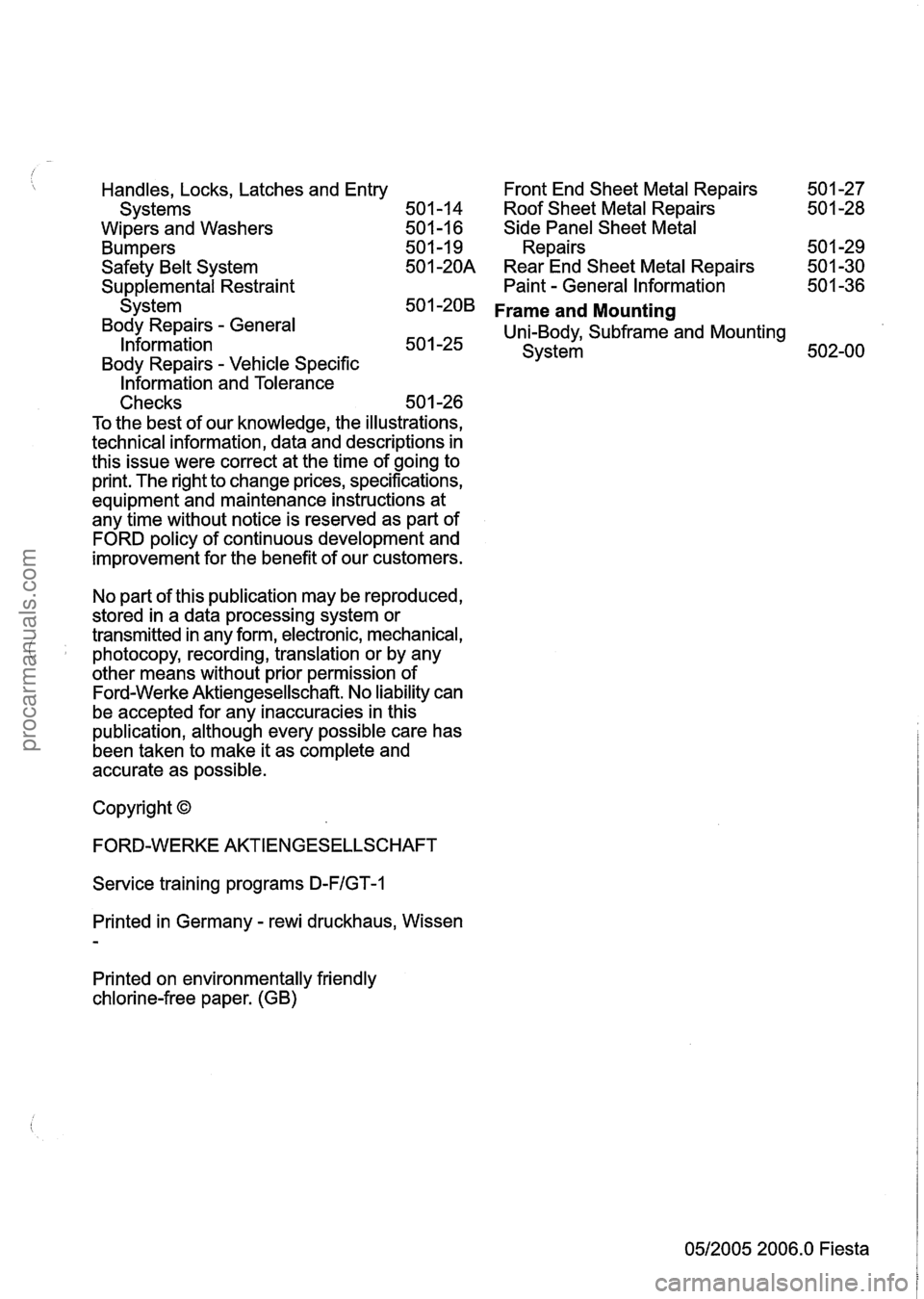
Handles, Locks, Latches and Entry Systems 501-14
Wipers and Washers 501-16
Bumpers 501-19
Safety Belt System 50
I -20A
Supplemental Restraint
System 501 -20B
Body Repairs
- General
Information 501 -25
Body Repairs
- Vehicle Specific
lnformation and Tolerance
Checks 501 -26
To the best of our knowledge, the illustrations,
technical information, data and descriptions in
this issue were correct at the time of going to
print. The right to change prices, specifications,
equipment and maintenance instructions at
any time without notice is reserved as part of
FORD policy of continuous development and
improvement for the benefit of our customers.
No part of this publication may be reproduced,
stored in a data processing system or
transmitted in any form, electronic, mechanical,
photocopy, recording, translation or by any
other means without prior permission of
Ford-Werke Aktiengesellschaft. No liability can
be accepted for any inaccuracies in this
publication, although every possible care has
been taken to make it as complete and
accurate as possible.
Copyright
O
FORD-WERKE AKTIENGESELLSCHAFT
Service training programs D-FIGT-1
Printed in Germany
- rewi druckhaus, Wissen -
Printed on environmentally friendly
chlorine-free paper. (GB) Front End Sheet Metal Repairs
50 1 -27
Roof Sheet Metal Repairs 50 1 -28
Side Panel Sheet Metal Repairs 501 -29
Rear End Sheet Metal Repairs 501
-30
Paint
- General Information 501
-36
Frame and Mounting
Uni-Body, Subframe and Mounting
System 502-00
0512005 2006.0 Fiesta
procarmanuals.com
Page 15 of 1226
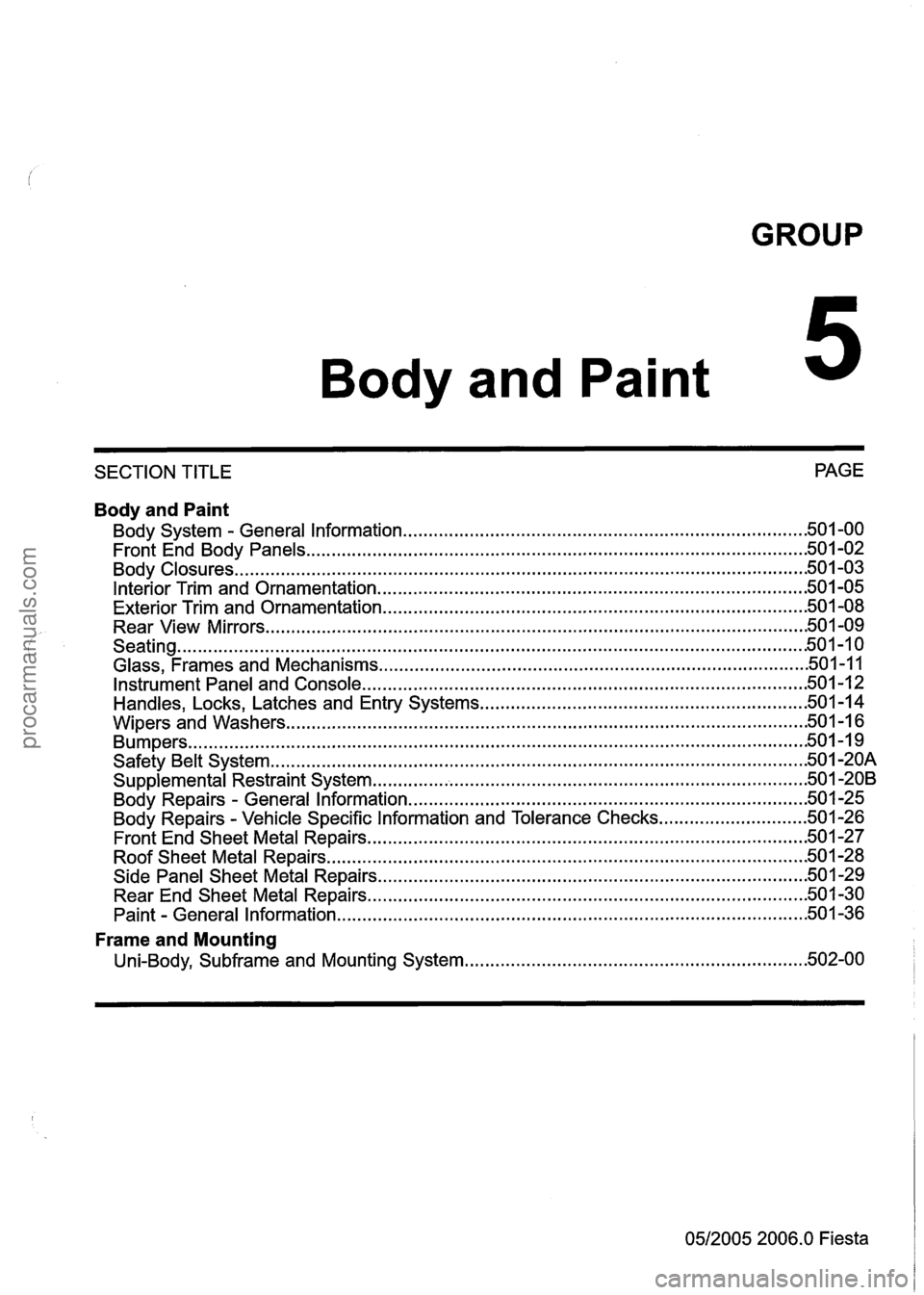
GROUP
Body and Paint
SECTION TITLE PAGE
Body and Paint
........................................................................\
.... Body System . General Information .50 1.00
........................................................................\
......................... Front End Body Panels .50 1.02
........................................................................\
........................................ Body Closures 501 -03
Interior Trim and Ornamentation ........................................................................\
............ 501-05
........................................................................\
.......... Exterior Trim and Ornamentation .50 1-08
........................................................................\
.................................. Rear View Mirrors 50 1 -09
........................................................................\
................................................... Seating 501 -10
........................................................................\
........... Glass, Frames and Mechanisms .SO1 1-1
........................................................................\
............... Instrument Panel and Console 502 1-1
............................................................... Handles, Locks, Latches and Entry Systems -501 -1 4
........................................................................\
............................. Wipers and Washers -501 -1 6
Bumpers ........................................................................\
................................................. 501 -1 9
........................................................................\
................................. Safety Belt System 50 I -2OA
........................................................................\
............. Supplemental Restraint System .50 I -2OB
Body Repairs - General Information ........................................................................\
...... 501-25
Body Repairs - Vehicle Specific Information and Tolerance Checks ............................. 501-26
........................................................................\
............. Front End Sheet Metal Repairs .50 1-27
........................................................................\
..................... Roof Sheet Metal Repairs -50 I -28
Side Panel Sheet Metal Repairs ........................................................................\
............ 501-29
........................................................................\
.............. Rear End Sheet Metal Repairs 50 1-30
........................................................................\
.................... Paint - General Information 501 -36
Frame and Mounting
Uni-Body, Subframe and Mounting System ................................................................... 502-00
0512005 2006.0
Fiesta
procarmanuals.com
Page 61 of 1226
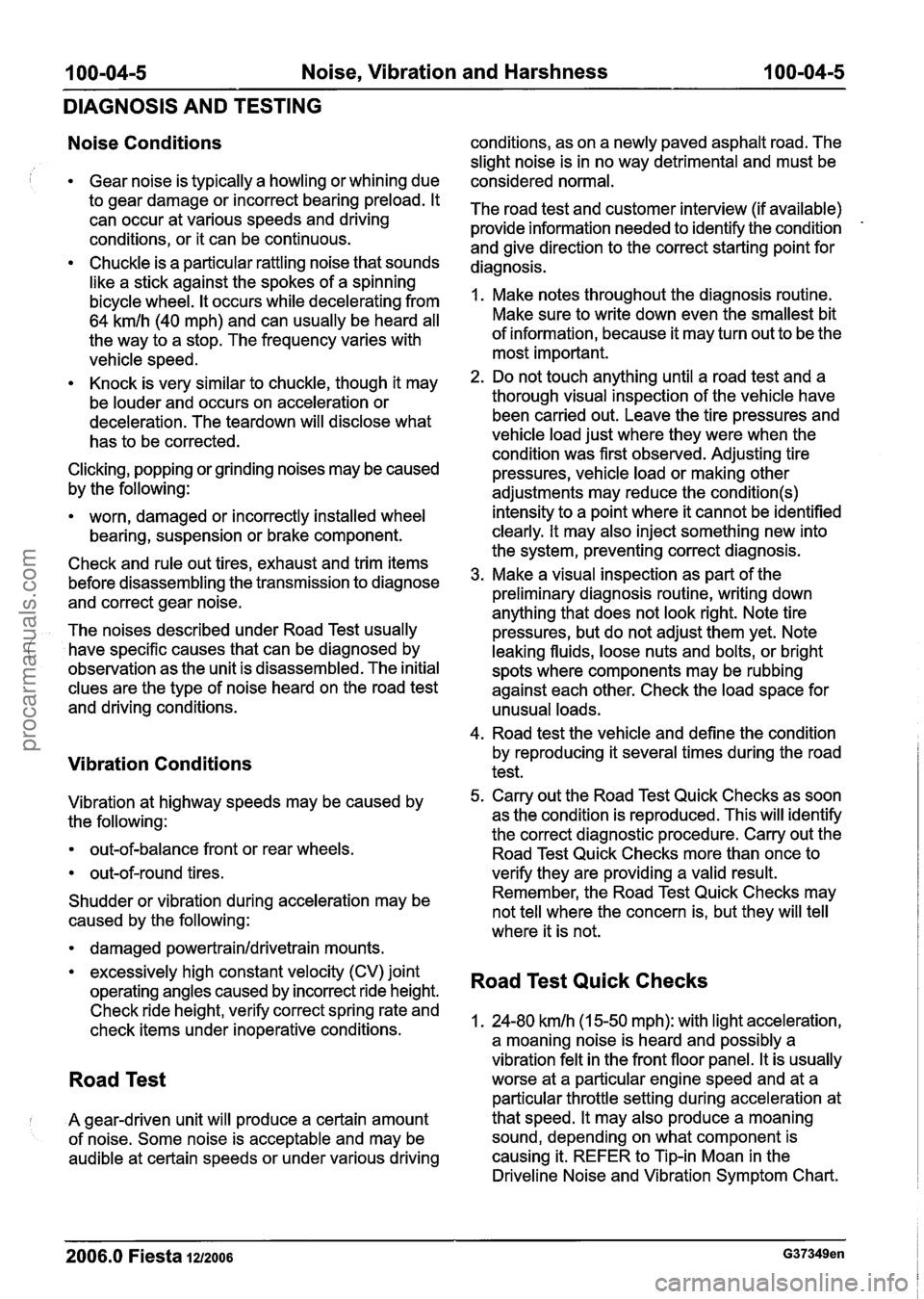
100-04-5 Noise, Vibration and Harshness 100-04-5
DIAGNOSIS AND TESTING
Noise Conditions
Gear noise is typically a howling or whining due
to gear damage or incorrect bearing preload. It
can occur at various speeds and driving
conditions, or it can be continuous.
Chuckle is a particular rattling noise that sounds
like a stick against the spokes of a spinning
bicycle wheel. It occurs while decelerating from
64
kmlh (40 mph) and can usually be heard all
the way to a stop. The frequency varies with
vehicle speed.
Knock is very similar to chuckle, though it may
be louder and occurs on acceleration or
deceleration. The
teardown will disclose what
has to be corrected.
Clicking, popping or grinding noises may be caused
by the following:
worn, damaged or incorrectly installed wheel
bearing, suspension or brake component.
Check and rule out tires, exhaust and trim items
before disassembling the transmission to diagnose
and correct gear noise.
The noises described under Road Test usually
( have specific causes that can be diagnosed by
observation as the unit is disassembled. The initial
clues are the type of noise heard on the road test
and driving conditions.
Vibration Conditions
Vibration at highway speeds may be caused by
the following:
out-of-balance front or rear wheels.
out-of-round tires.
Shudder or vibration during acceleration may be
caused by the following:
damaged powertrainldrivetrain mounts.
excessively high constant velocity (CV) joint
operating angles caused by incorrect ride height.
Check ride height, verify correct spring rate and
check items under inoperative conditions.
Road Test
I A gear-driven unit will produce a certain amount
of noise. Some noise is acceptable and may be
audible at certain speeds or under various driving conditions,
as on a newly paved asphalt road. The
slight noise is in no way detrimental and must be
considered normal.
The road test and customer interview (if available)
provide information needed to identify the condition
-
and give direction to the correct starting point for
diagnosis.
1. Make notes throughout the diagnosis routine.
Make sure to write down even the smallest bit
of information, because it may turn out to be the
most important.
2. Do not touch anything until a road test and a
thorough visual inspection of the vehicle have been carried out. Leave the tire pressures and
vehicle load just where they were when the
condition was first observed. Adjusting tire
pressures, vehicle load or making other
adjustments may reduce the
condition(s)
intensity to a point where it cannot be identified
clearly. It may also inject something new into
the system, preventing correct diagnosis.
3. Make a visual inspection as part of the
preliminary diagnosis routine, writing down
anything that does not look right. Note tire
pressures, but do not adjust them yet. Note
leaking fluids, loose nuts and bolts, or bright
spots where components may be rubbing
against each other. Check the load space for
unusual loads.
4. Road test the vehicle and define the condition
by reproducing it several times during the road
test.
5. Carry out the Road Test Quick Checks as soon
as the condition is reproduced. This will identify
the correct diagnostic procedure. Carry out the
Road Test Quick Checks more than once to
verify they are providing a valid result.
Remember, the Road Test Quick Checks may
not tell where the concern is, but they will tell
where it is not.
Road Test Quick Checks
1. 24-80 kmlh (1 5-50 mph): with light acceleration,
a moaning noise is heard and possibly a
vibration felt in the front floor panel. It is usually
worse at a particular engine speed and at a
particular throttle setting during acceleration at
that speed. It may also produce a moaning
sound, depending on what component is
causing it. REFER to Tip-in Moan in the
Driveline Noise and Vibration Symptom Chart.
2006.0 Fiesta 1212006 G37349en
procarmanuals.com
Page 62 of 1226
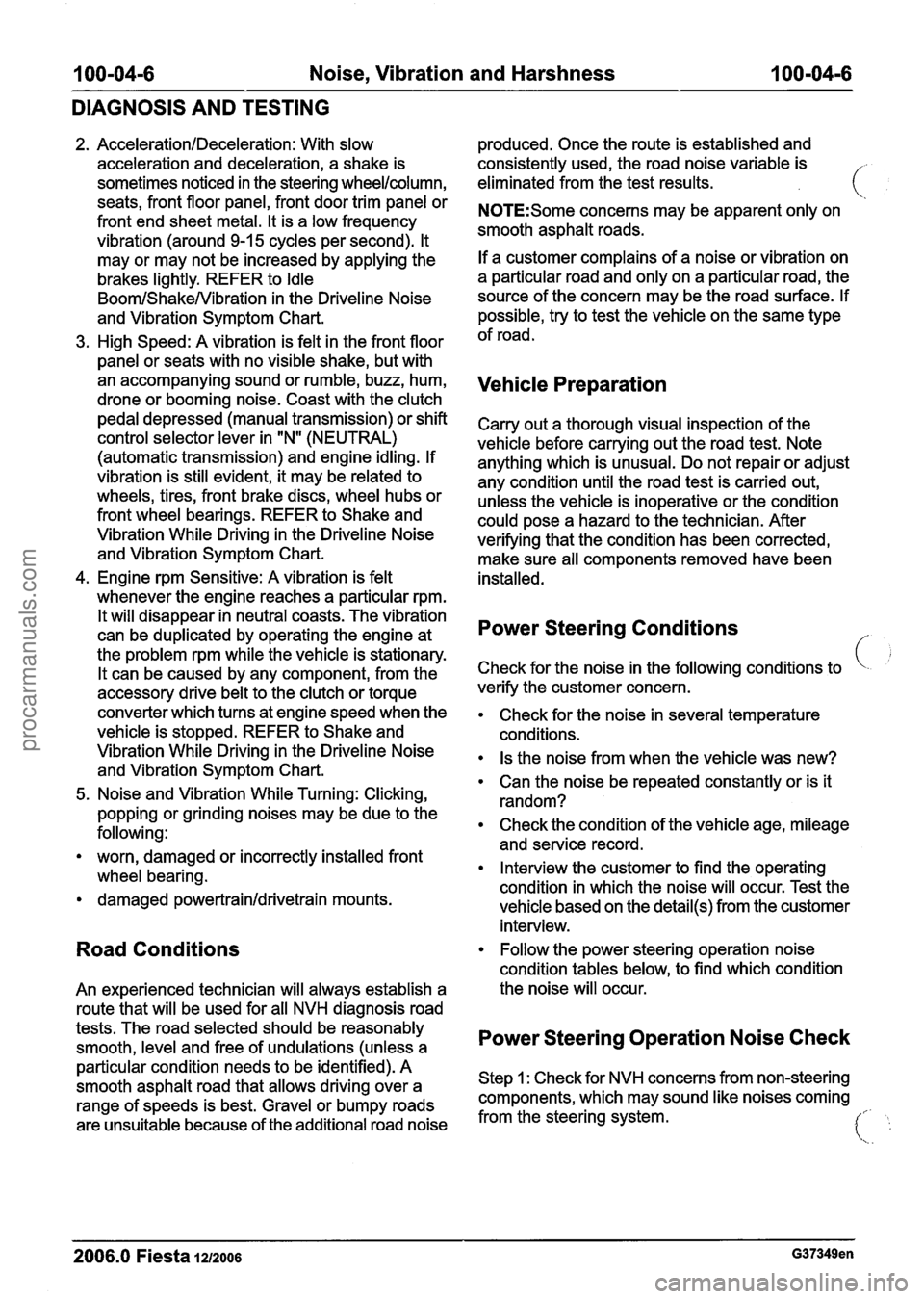
100-04-6 Noise, Vibration and Harshness 100-04-6
DIAGNOSIS AND TESTING
2. AccelerationIDeceleration: With slow
acceleration and deceleration, a shake is
sometimes noticed in the steering
wheellcolumn,
seats, front floor panel, front door trim panel or
front end sheet metal. It is a low frequency
vibration (around
9-1 5 cycles per second). It
may or may not be increased by applying the
brakes lightly. REFER to
Idle
BoomIShakeNibration in the Driveline Noise
and Vibration Symptom Chart.
High Speed: A vibration is felt in the front floor
panel or seats with no visible shake, but with
an accompanying sound or rumble, buzz, hum,
drone or booming noise. Coast with the clutch
pedal depressed (manual transmission) or shift
control selector lever in "N" (NEUTRAL)
(automatic transmission) and engine idling. If
vibration is still evident, it may be related to
wheels, tires, front brake discs, wheel hubs or
front wheel bearings. REFER to Shake and
Vibration While Driving in the Driveline Noise
and Vibration Symptom Chart.
4. Engine rpm Sensitive: A vibration is felt
whenever the engine reaches a particular rpm.
It will disappear in neutral coasts. The vibration
can be duplicated by operating the engine at
the problem rpm while the vehicle is stationary.
It can be caused by any component, from the
accessory drive belt to the clutch or torque
converter which turns at engine speed when the
vehicle is stopped. REFER to Shake and
Vibration While Driving in the Driveline Noise
and Vibration Symptom Chart.
5. Noise and Vibration While Turning: Clicking,
popping or grinding noises may be due to the
following:
worn, damaged or incorrectly installed front
wheel bearing.
damaged
powertrainldrivetrain mounts.
Road Conditions
An experienced technician will always establish a
route that will be used for all NVH diagnosis road
tests. The road selected should be reasonably
smooth, level and free of undulations (unless a
particular condition needs to be identified). A
smooth asphalt road that allows driving over a
range of speeds is best. Gravel or bumpy roads
are unsuitable because of the additional road noise produced.
Once the route is established and
consistently used, the road noise variable is
eliminated from the test results.
N0TE:Some concerns may be apparent only on
smooth asphalt roads.
If a customer complains of a noise or vibration on
a particular road and only on a particular road, the
source of the concern may be the road surface. If
possible, try to test the vehicle on the same type
of road.
Vehicle Preparation
Carry out a thorough visual inspection of the
vehicle before carrying out the road test. Note
anything which is unusual. Do not repair or adjust
any condition until the road test is carried out,
unless the vehicle is inoperative or the condition
could pose a hazard to the technician. After
verifying that the condition has been corrected,
make sure all components removed have been
installed.
Power Steering Conditions
c !
Check for the noise in the following conditions to
verify the customer concern.
Check for the noise in several temperature
conditions.
Is the noise from when the vehicle was new?
Can the noise be repeated constantly or is it
random?
Check the condition of the vehicle age, mileage
and service record.
Interview the customer to find the operating
condition in which the noise will occur. Test the
vehicle based on the
detail(s) from the customer
interview.
Follow the power steering operation noise
condition tables below, to find which condition
the noise will occur.
Power Steering Operation Noise Check
Step 1 : Check for NVH concerns from non-steering
components, which may sound like noises coming
from the steering system.
I:. ':
2006.0 Fiesta 121zoo6 G37349en
procarmanuals.com